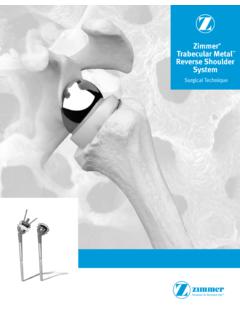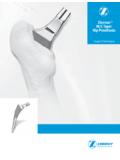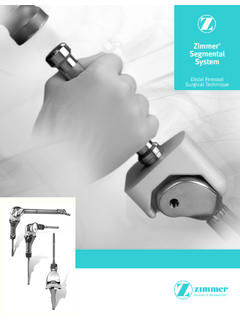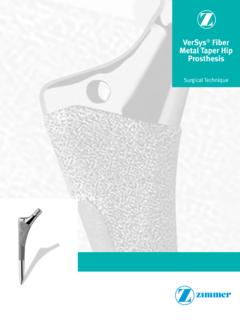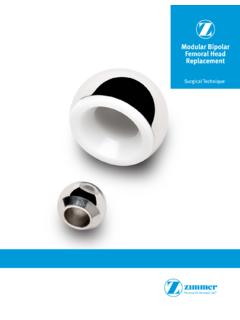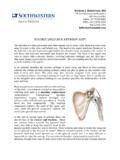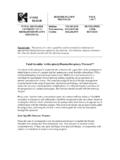Transcription of Trabecular Metal Reverse Shoulder System - …
1 Trabecular Metal . Reverse Shoulder System Surgical Technique Table of Contents 2. The Implant 2. Patient 2. Incision and 2. Description of the 4. Trabecular Metal Reverse Shoulder Sizing 5. Humeral 6. Superior Cut Guide Assembly and 11. Proximal Humeral 14. Glenoid 15. Non-Cannulated and Cannulated 20. Implant Insertion ( Reverse Application).. 26. Hemi-Arthroplasty or Total Arthroplasty 32. Implant Insertion (Hemi/Total Application).. 34. 37. Postoperative 37. Appendix 38. Appendix 42. Appendix 43. Appendix 43. 2 | Trabecular Metal Reverse Shoulder System Surgical Technique Foreword Patient Positioning Total Shoulder replacement has evolved as a Patient positioning is especially important in Shoulder biomechanically logical reconstruction of the Shoulder .
2 Surgery. Place the patient in a semi beach-chair Reconstruction using the humeral component of position with the knees flexed ( Figure 1). Raise the the Trabecular Metal Reverse Shoulder System head of the table approximately 25-30 degrees to in conjunction with the Bigliani/Flatow glenoid reduce the venous pressure. Use a head rest that allows component allows the potential for the surgeon to for the superior part of the table to be removed. Place restore the geometry of a normal joint, thus ensuring two towels under the spine and the medial border of good motion and pain relief, as well as durability of the the scapula to raise the affected side. The torso should reconstruction.
3 Be at the edge of the table. The Shoulder will be off the edge of the table. Attach a short arm board to the table, When there is severe distortion of osseous anatomy or use another arm support method that will allow the or loss of normal rotator cuff tendon structure, arm to be raised or lowered as necessary throughout anatomical restoration of the glenohumeral joint is not the procedure. possible. Patients who have severe loss of rotator cuff function may present with a pseudoparalysis as well as with pain. In such situations, reconstruction in order to restore function is possible using a Reverse solution. The Trabecular Metal Reverse Shoulder option offers the ability for potential pain relief and restoration of function using the same humeral stem for Reverse or hemi-arthroplasty applications.
4 Figure 1. The Implant System The assembled humeral component may be used alone Incision and Exposure for hemiarthroplasty or combined with the glenoid There are two possible surgical approaches to the component or Reverse components for total Shoulder Shoulder for Reverse arthroplasty. The superior- arthroplasty (conventional or Reverse applications). lateral approach relies on a deltoid split similar to a rotator cuff procedure. It allows a more direct view The Trabecular Metal Reverse humeral components and instrumentation of the glenoid. However, inferior are intended for either cemented or press-fit use. The positioning of the glenoid base plate may be more Reverse base plate requires two screws for fixation.
5 Difficult and care to avoid excessive deltoid splitting is essential to minimize risk to the axillary nerve. The delto-pectoral approach will allow easier access to the proximal humerus if there are post-traumatic changes or prior arthroplasty. Additionally, it will allow easier access to the inferior portion of the glenoid. The choice of approach is the surgeon's preference, but the delto-pectoral approach is typically preferred for revision surgery. 3 | Trabecular Metal Reverse Shoulder System Surgical Technique Superior-Lateral Approach The incision is made from the anteriolateral acromial border downward approximately 4cm. Following subcutaneous dissection, the anterior and middle deltoid muscle bundles are separated opposite the lateral margin of the acromion through the tendinous raphe.
6 Care should be taken to avoid any damage to the axillary nerve, which is located approximately 5-7cm distal to the acromion. After excision of the scarred and inflamed subacromial bursa, gentle longitudinal traction in line with the limb will allow an elevator to be placed into the joint. The humeral head is dislocated by herniating the proximal humerus through the rotator cuff defect. To optimize the exposure, the anterior border and the rest of the superior cuff can be released. Delto-Pectoral Approach Make a skin incision in a straight line starting from the lateral edge of the coracoid as far as the insertion of the deltoid muscle. Seek the cephalic vein between the deltoid muscle and the pectoralis major muscle.
7 The cephalic vein can be taken either medially or laterally to open the delto-pectoral interval. The clavi- pectoral fascia is incised at the external border of the coracobrachialis. The axillary nerve is then identified just medial to the musculotendinous junction of the subscapularis. Often the subdeltoid bursa is inflamed and scarred and must be sharply excised for exposure. The remnant of the subscapularis is released and tagged for potential later repair. The inferior capsule is then released allowing a traumatic dislocation of the humeral head by adduction of the arm with progressive external rotation and extension. 4 | Trabecular Metal Reverse Shoulder System Surgical Technique Description of the Implants Trabecular Metal Base Plate Small diameter to preserve glenoid bone Trabecular Metal surface for the potential of improved fixation 28mm diameter Trabecular Metal base plate pad Standard 15mm Trabecular Metal center post (shown) Inverse/ Reverse Screw System Available 25 or 30mm center post with +2mm lateral diameter self-tapping Inverse/.
8 Offset in Titanium substrate Reverse Screws Accepts 2 Inverse/ Reverse Screws Variable angulations to a maximum 30 . arc for both, the superior screw in order Trabecular Metal to engage base of the coracoid process Reverse Poly Liner and to obtain good cortical fixation, and Available in UHMWPE or Vivacit-E HXPE. Trabecular Metal Reverse also the inferior screw in order to engage 60 Standard Liner Glenoid Heads the pillar of the scapula to obtain good 36mm and 40mm 2 diameters: cortical fixation 3 thicknesses: +0mm, 36mm and 40mm +3mm, and +6mm A locking screw cap will fix and secure Morse taper for the desired angle of each Inverse/. 65 Retentive Liner 36mm and 40mm secure fixation Reverse Screw 3 thicknesses: +0mm, +3mm, and +6mm Spacer (optional).
9 2 Sizes +9mm and +12mm Non-Porous Reverse Humeral Stem Morse taper for secure fixation Titanium stem Trabecular Metal Reverse Humeral Stem Each size accepts both standard Convertible from Reverse to Hemi and Hemi to Reverse Cuff Tear Arthropathy with and retentive liners osteoarthitis Fracture Repair/Reconstruction Proximal Trabecular Metal surface for the potential of Numerous stem diameters improved fixation and lengths Six suture holes 6, 8, 9, 10, 11, 12, 13, Proximal suture groove 14, 15, 16, 18 x 130mm Small proximal conical shape to preserve proximal humeral 8, 10, 12, 14, 16 x 200mm bone stock Ability to use cemented or Multiple stem diameters and lengths uncemented configurations 8, 10, 12, 14, 16, 18 x 130mm 8, 10, 12, 14, 16 x 170mm Ability to use cemented and uncemented configurations Note: Do not use this product with components from other Shoulder systems unless they are expressly labeled as compatible.
10 5 | Trabecular Metal Reverse Shoulder System Surgical Technique Trabecular Metal Reverse Shoulder Sizing Chart The sizing chart below shows the dimensions of the Trabecular Metal Reverse Stem, provisionals, and the reamers taken at four points along their bodies. Lines 1 and 2 correspond to locations prepared by the proximal reamer, whereas points 3 and 4 correspond to locations prepared by the distal reamer. Under the RELATIONSHIP section, the dimensions of the A.) Provisional and B.) Stem are compared to those of the reamers. These numbers represent the amount of circumferential press-fit (+) or clearance-fit (-) expected in each zone. Use this chart to determine the best size stem for press-fit and cemented applications.

